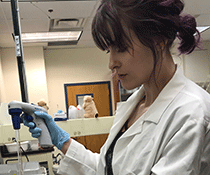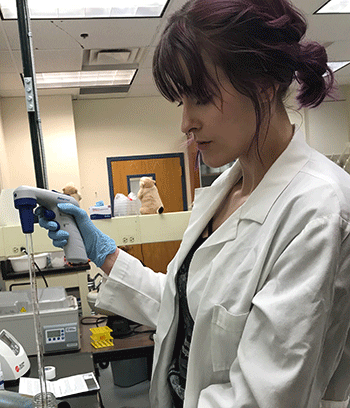
NMT Biology Grad Student Examining Antibiotic Resistant Genes in Wastewater
aug 1, 2018

New Mexico Tech graduate student in biology Angelica Cave recently landed a grant from the NMSU’s Water Resource Research Institute to support her study of antibiotic-resistant bacteria in wastewater treatment.
Her proposal is titled “Antibiotic resistance in wastewater treatment: the effects of different treatment methods on the differential survival of antibiotic resistant pathogens over non-resistant bacteria through the treatment process of two different wastewater treatment plants.”
Cave, along with her advisor Dr. Linda DeVeaux, will collect and examine samples taken from in-coming sewage, the aerobic digester, and the treated wastewater, as well as from the channel the waste water is discharged into both upstream and downstream from the Socorro Wastewater Treatment Plant. Collaborators in South Dakota will be conducting similar studies. Both areas have similar “interference” from agriculture and livestock.
“I hope to find out if bacteria carrying antibiotic resistance genes have a better
chance of surviving the treatment processes used in the two wastewater treatment plants,”
she said. “We’ll be looking primarily at two panels of genes – 7 pathogenicity genes and
10 genes that indicate
resistance to beta-lactam antibiotics.”
Cave is taking samples from untreated wastewater, the aerobic digester, where the organic material gets broken down and is the most biologically significant step in the treatment process at the Socorro plant, the treated wastewater, and the channel the wastewater is discharged into, both upstream and downstream from the plant, as the treated wastewater is being discharged.
She will analyze those various samples to determine the presence of antibiotic resistant genes (ARGs) and virulence genes (VGs). The relative proportion of bacteria carrying ARGs over those that don’t will be determined to show whether the presence of ARGs provides increased survivability to bacteria going through the current wastewater treatment practices in the two treatment plants. Cave will take samples multiple times in the next year over the course of months to allow for the effects of temporal changes to be seen, which will allow insight into the potential dynamics of ARBs in the environment.
Once samples are collected, Cave will conduct two studies: first, she will extract genomic DNA from the original environmental samples using the Qiagen PowerWater or PowerFecal extraction kits, and testing those extractions for the VGs and ARGs, and second, she will culture Gram- negative bacilli using MacConkey Agar from samples that showed the genes of interest, to isolate the bacteria which contain those genes. Additionally, she will test isolates of interest to determine if that isolate is resistant to multiple classes of antibiotics.
Cave said this project will provide new information about the possible connections
between
antibiotic resistant genes and antibiotic resistant bacteria in the environment and
wastewater treatment practices. She said this is so important because a link between
the spread of ARB and ARGs and wastewater treatment plants has long been suspected
and, although it hasn’t been confirmed definitively, there are studies that support
this theory and more research is greatly needed. Antibiotic resistant infections are
becoming an increasing threat to public health and safety, which makes this sort of
research timely and important.
Cave said this project has the potential to benefit the Socorro community by providing insight into the presence of antibiotic resistance in the local surface water, which may lead to better antibiotic stewardship practices in the local clinics. She said this sort of community project can raise awareness of our local community and foster further relationships between NMT and the Socorro community.
“Without this grant, it’d be difficult for our lab to afford everything we need for this project,” she said. “I’m really excited to have the opportunity to present this research at the WRRI research conference in October.”
An Albuquerque native, Cave started her college career at Central New Mexico Community College. There, she took prerequisite courses for the Diagnostic Medical Sonography program offered at CNM, which exposed her to math and science for the first time.
“I fell in love with biology and chemistry,” she said. “I decided on New Mexico Tech because it had a very similar feel to CNM with the smaller class sizes and sense of community.”
She earned her bachelor’s in biology at NMT and decided to stay for a master’s. She is interested in pursuing a career in public health and the microbiology of how antibiotic resistance moves through the environment.
“It’s a big unknown,” she said. “We don’t know how wastewater treatment factors in
to the
spread of ARGs in the environment, and I’d like to pursue that question further.”